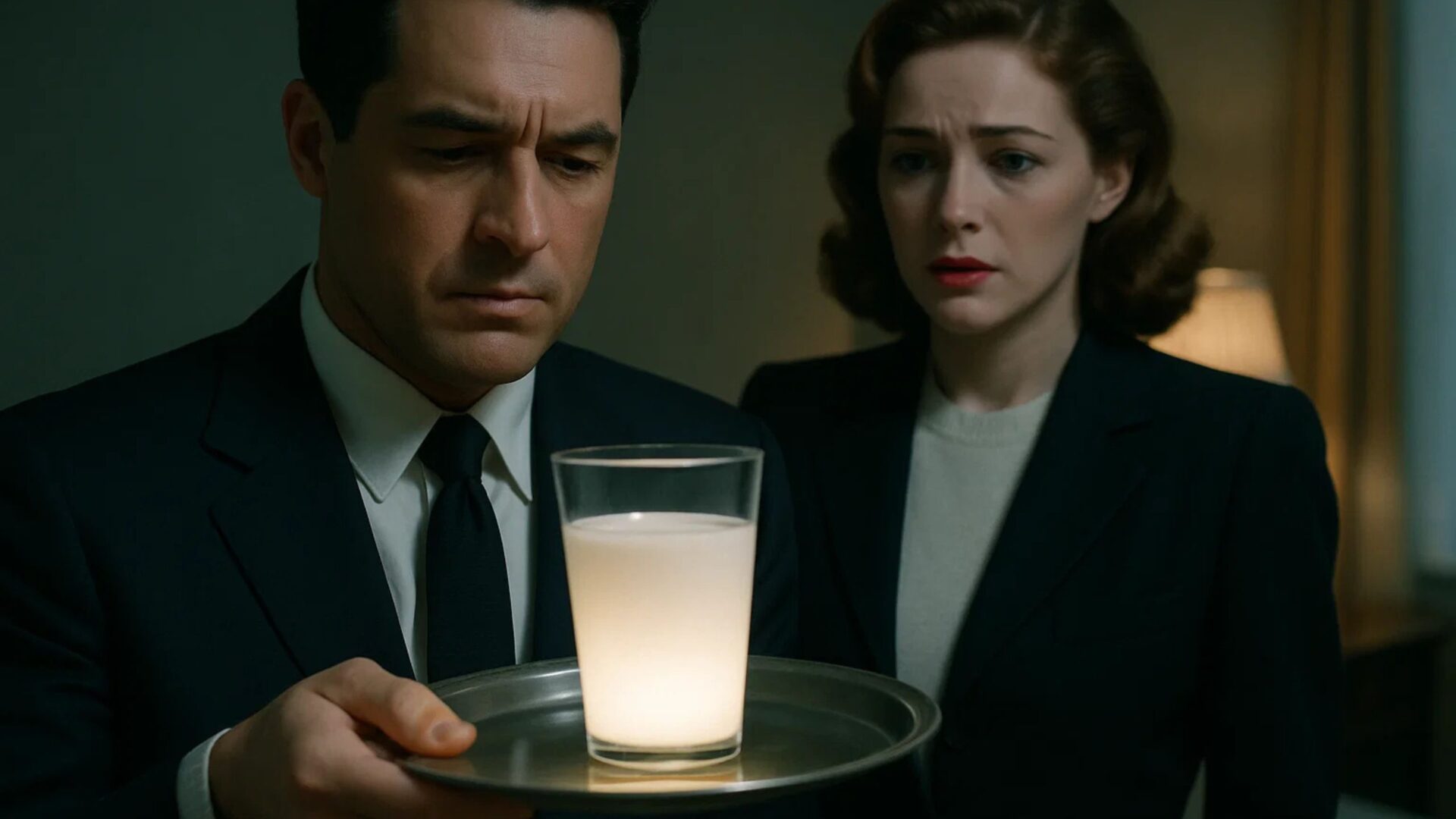The Psychology of Suspicion: Roots, Causes, and the Projection of the Inner Shadow
He kissed her so softly that it should have been comforting, but instead it made her stomach twist with doubt. Why was it so soft? His eyes held the same steady look she’d always known, but she didn’t believe it. Not really. There had to be something he was hiding.
It all came back to that one stupid night — the employee Christmas party where she’d had a little too much to drink, where her dress had ended up torn and so had her heart. The shame, the disbelief that she had let herself be unfaithful, had been buried for years, carefully hidden from him. She had buried it under years of marriage, but rot has a way of finding daylight. And now it poisoned her trust in everything he did. His touch. His embrace. His loving words. Even the simple “I love you, baby” felt layered with hidden motives, as if every syllable might be a trap.
Her nights spent rifling through his phone had left her exhausted, wrung out in a way that no apology or explanation could fix. Yet she couldn’t stop herself. Couldn’t stop questioning. Couldn’t escape the spiral. And the worst part? There was no way out. Not really.
Except for one slow way out. Now she punished herself in smaller, quieter ways. She skipped meals. She stayed awake until dawn, staring at the ceiling. She stopped calling friends back. Every choice, every little neglect, was a way to make herself fade—inch by inch—without anyone noticing. Not even the little lead balls she ate secretly every day. One, a few, to poison herself out of this situation and eventually out of this world.
Abstract
Suspicion is a fundamental yet destructive psychological force that distorts perception, erodes trust, and reshapes human relationships. This essay explores the roots and causes of suspicion from biological, emotional, and psychoanalytic perspectives, emphasizing the mechanism of projection — the process through which individuals attribute their repressed insecurities to others. Through literary and cinematic examples, including Othello, Hitchcock’s Suspicion, Fincher’s Gone Girl, and Trading Places, the paper demonstrates how suspicion has evolved from an individual pathology to a societal condition. Ultimately, it argues that overcoming suspicion requires confronting one’s inner shadow, cultivating empathy, and restoring the fragile act of trust.
Keywords: suspicion, psychology, projection, relationships, trust, Jung, Freud, behaviorism, cinema, literature
1. Introduction
Suspicion is among the most subtle and corrosive forces within the human psyche. It emerges when the fragile structure of trust — the foundation of relationships and social cooperation — becomes poisoned by uncertainty and fear. The psychology of suspicion reveals how individuals interpret ambiguity through the lens of insecurity, projecting internal anxiety onto others.
From the ancient Stoics to modern psychoanalysis, thinkers have seen suspicion as both a defense mechanism and a form of self-deception. It protects against potential harm but, when unrestrained, becomes a self-fulfilling prophecy. The suspicious mind constructs evidence from imagination, seeing betrayal in every silence, danger in every glance.
2. Roots and Causes of Suspicion
a) Evolutionary and Biological Foundations
Suspicion has its roots in evolutionary psychology as an adaptive survival mechanism. Early humans depended on distinguishing friend from foe — a vigilance that increased survival in hostile environments (Cosmides & Tooby, 1992). This instinct evolved into social cognition, allowing humans to detect deception and predict others’ intentions. However, when hyperactivated, this vigilance turns pathological.
Neurological studies show that in suspicious individuals, the amygdala — the brain’s center for threat detection — reacts even to ambiguous stimuli (Adolphs, 2002). What once ensured safety now distorts social perception, transforming uncertainty into perceived hostility.
b) Psychological and Emotional Factors
Suspicion frequently stems from insecure attachment, past betrayal, or low self-esteem. Bowlby’s attachment theory (1969) explains that individuals raised with inconsistent caregiving often internalize fear of abandonment, later manifesting as mistrust in adulthood.
Freud (1911) identified suspicion as a derivative of projection, a defense mechanism through which one disowns unwanted thoughts or desires and attributes them to others. In this psychological inversion, an unfaithful person suspects infidelity, a deceitful person fears deceit. Suspicion becomes the mind’s way of seeing in others what it cannot accept in itself.
3. Projection: “I See My Own Shadow on You”
Carl Jung deepened Freud’s insight with his concept of the Shadow — the unconscious repository of all traits an individual represses. When one fails to integrate this shadow, the psyche compensates by projecting it outward. Jung wrote,
“Everything that irritates us about others can lead us to an understanding of ourselves.” (Aion, 1951)
In relationships, projection becomes the invisible architect of suspicion. The jealous lover is often not reading another’s deceit, but their own capacity for it. The controlling partner does not mistrust the other — they mistrust themselves. As projection intensifies, perception becomes infected; reality is no longer observed but manufactured to fit inner narratives.
4. Suspicion in Literature and Film
Suspicion has fascinated artists and thinkers for centuries because it dramatizes the inner conflict between faith and fear. From Shakespeare’s Othello to Hitchcock’s Suspicion, Fincher’s Gone Girl, and Landis’s Trading Places, each work reveals a unique psychological terrain where doubt transforms human relationships into battlegrounds of the mind.
a) William Shakespeare’s Othello (1603): The Tragedy of a Projected Shadow
In Shakespeare’s timeless tragedy, Othello, a Moorish general in the Venetian army, secretly marries Desdemona, a noblewoman who defies her father for love. The villain Iago, envious of Othello’s position, exploits his master’s insecurity by insinuating that Desdemona has been unfaithful with his lieutenant Cassio.
At first, Othello resists the thought, but once suspicion enters, every small act becomes evidence of guilt. The misplaced handkerchief — a mere accident — becomes proof of adultery. Iago’s manipulation succeeds because it feeds what already exists within Othello: the fear of being unworthy of love.
Iago warns him:
“O, beware, my lord, of jealousy;
It is the green-eyed monster which doth mock
The meat it feeds on.” (Act 3, Scene 3)
Othello’s projection turns love into rage. In the final scene, convinced of Desdemona’s betrayal, he smothers her as she pleads her innocence:
“Yet she must die, else she’ll betray more men.
Put out the light, and then put out the light.” (Act 5, Scene 2)
The tragedy concludes when Othello realizes the truth too late. His suspicion, not Iago’s deceit, was the true murderer. Shakespeare exposes the essence of projection: the shadow we deny within ourselves becomes the monster we see in those we love.
b) Alfred Hitchcock’s Suspicion (1941): Fear, Imagination, and the Feminine Mind
In Hitchcock’s psychological thriller, Lina McLaidlaw (Joan Fontaine), a quiet and intelligent woman, marries the charming yet secretive Johnnie Aysgarth (Cary Grant). Over time, she begins to suspect that her husband intends to kill her for her inheritance. Every act — his financial lies, his evasive behavior, the glowing glass of milk he carries upstairs — becomes a symbol of danger.
Hitchcock masterfully traps the audience inside Lina’s mind, where imagination amplifies uncertainty. The film blurs the line between genuine threat and paranoid fantasy. Lina’s world becomes a hall of mirrors: is Johnnie truly murderous, or is she projecting her own repressed fears?
In one iconic scene, the camera lingers on the luminous milk glass — lit from within — as Johnnie ascends the staircase. It is an image of pure psychological terror, showing how suspicion transforms the mundane into the menacing.
Although the studio forced Hitchcock to end the film by revealing Johnnie’s innocence, his intended version had Lina’s suspicion leading to her own demise — a darker truth that the mind can destroy itself when it cannot trust what it loves.
Suspicion thus becomes a study in the female experience of projection, showing how social powerlessness and inner fear intertwine into self-doubt and imagined danger.
c) David Fincher’s Gone Girl (2014): The Marriage of Deceit and Surveillance
David Fincher’s Gone Girl translates the ancient psychology of suspicion into the digital age of media manipulation. Nick and Amy Dunne’s marriage appears ideal until Amy disappears on their fifth anniversary. As the investigation unfolds, public suspicion turns toward Nick, whose lies, infidelity, and odd behavior make him appear guilty. But the twist reveals that Amy has orchestrated her disappearance to frame Nick for murder — an act born from her own wounded pride and need for control.
Amy’s monologue exposes the pathology of modern suspicion:
“Everyone told us marriage is hard work. Not for me and Nick. What’s hard work is pretending to be this happy couple when we’re not.”
The film becomes a mirror for the performative nature of trust in the digital age. Social media transforms private lives into staged performances, where each partner monitors the other’s online persona. Suspicion is no longer a personal delusion but a cultural condition.
Fincher’s meticulous direction turns marriage into a chessboard of deceit — love as strategy, intimacy as surveillance. Both partners manipulate public image as a form of power. The result is a haunting portrait of how mutual suspicion can replace affection, leaving only image management where emotional honesty once lived.
d) John Landis’s Trading Places (1983): Behaviorism, Prejudice, and Social Suspicion
Though comedic, Trading Places rests on a profoundly psychological premise. Two wealthy brothers, Randolph and Mortimer Duke, debate whether success depends on heredity or environment. To prove their point, they cruelly engineer a social experiment: they destroy the privileged life of Louis Winthorpe III (Dan Aykroyd) and elevate the life of a street hustler, Billy Ray Valentine (Eddie Murphy), placing each in the other’s position.
The experiment echoes John B. Watson’s and B.F. Skinner’s behaviorism, demonstrating how human behavior can be shaped entirely by environment and conditioning. Yet beneath its humor, the film critiques systemic suspicion — the assumption that class, race, or social background determine morality.
Winthorpe’s descent into paranoia, believing everyone conspires against him, mirrors Othello’s inner collapse. Meanwhile, Valentine, once distrusted by society, learns how suspicion functions as a tool of oppression.
In the end, when the two men unite to expose and ruin the Dukes, the film suggests that suspicion, once directed inward and socially weaponized, can also awaken moral awareness. Trading Places transforms private paranoia into social critique, showing that structural mistrust — between rich and poor, black and white — is the collective form of the individual’s psychological projection.
Synthesis: From Private Fear to Cultural Condition
Across these four works, suspicion evolves from an intimate emotion into a cultural phenomenon.
-
In Othello, it is the shadow of jealousy.
-
In Suspicion, the echo of imagination.
-
In Gone Girl, the digital masquerade of modern relationships.
-
In Trading Places, the systemic prejudice embedded in social structures.
Each narrative demonstrates the same psychological truth: suspicion is not a reaction to others but a reflection of oneself. It begins in projection, grows through imagination, and ends in isolation. The more we fear betrayal, the more we conjure it into being.
5. Real-World Manifestations: When Suspicion Destroys
Suspicion extends beyond fiction into history and society.
The McCarthy era of the 1950s turned political paranoia into a national epidemic, where fear of communism led to mass accusations, blacklists, and ruined lives — a collective projection of internal insecurity.
In intimate life, psychologists describe Othello Syndrome (Todd & Dewhurst, 1955) as a clinical form of delusional jealousy. It is characterized by obsessive surveillance, false accusations, and emotional abuse. Such pathology illustrates that suspicion, when unchecked, not only distorts love but erases personal identity.
In contemporary culture, social media accelerates this dynamic. Algorithms amplify suspicion, rewarding outrage and distrust. The individual’s psychological mechanism of projection becomes the collective condition of the digital crowd.
6. Healing from Suspicion: Integrating the Shadow
The antidote to suspicion is not naïve trust but self-awareness. Jungian analysis, mindfulness, and cognitive-behavioral therapy (CBT) all emphasize recognizing projection as the first step to reclaiming inner balance.
To heal, one must reclaim the shadow — not deny it. This means confronting insecurity, jealousy, and fear within, rather than externalizing them. Viktor Frankl reminds us:
“Between stimulus and response there is a space. In that space is our power to choose our response.” (Man’s Search for Meaning, 1946)
Suspicion lives in the absence of that space; healing begins when consciousness reopens it. In relationships, honest dialogue and empathy replace silent accusation. In societies, transparency and fairness replace systemic mistrust.
7. Conclusion
Suspicion is both ancient and modern — as primal as survival and as current as the digital feed. It begins as a whisper of fear but can grow into a hurricane of destruction. Whether in Othello’s jealous rage, Lina’s anxious imagination, Amy’s performative vengeance, or the Dukes’ social experiment, suspicion reveals a universal truth: what we fear most in others often lives within ourselves.
To overcome suspicion is not to erase doubt, but to integrate it — to let awareness transform fear into understanding. Only by recognizing our projections can we see others clearly. And only through trust — fragile, deliberate, and renewed — can love and community survive.
References
-
Adolphs, R. (2002). Neural systems for recognizing emotion. Current Opinion in Neurobiology.
-
Bowlby, J. (1969). Attachment and Loss: Vol. 1. Attachment. Basic Books.
-
Cosmides, L., & Tooby, J. (1992). Cognitive adaptations for social exchange. In J. Barkow et al. (Eds.), The Adapted Mind. Oxford University Press.
-
Dostoevsky, F. (1880). The Brothers Karamazov.
-
Fincher, D. (Director). (2014). Gone Girl [Film]. 20th Century Fox.
-
Frankl, V. (1946). Man’s Search for Meaning. Beacon Press.
-
Freud, S. (1911). Psycho-Analytic Notes on an Autobiographical Account of a Case of Paranoia (Dementia Paranoides).
-
Hitchcock, A. (Director). (1941). Suspicion [Film]. RKO Pictures.
-
Jung, C. G. (1951). Aion: Researches into the Phenomenology of the Self. Princeton University Press.
-
Landis, J. (Director). (1983). Trading Places [Film]. Paramount Pictures.
-
Shakespeare, W. (1603). Othello. London: First Folio.
-
Todd, J., & Dewhurst, K. (1955). The Othello Syndrome: A Study in the Psychopathology of Sexual Jealousy. Journal of Nervous and Mental Disease.



